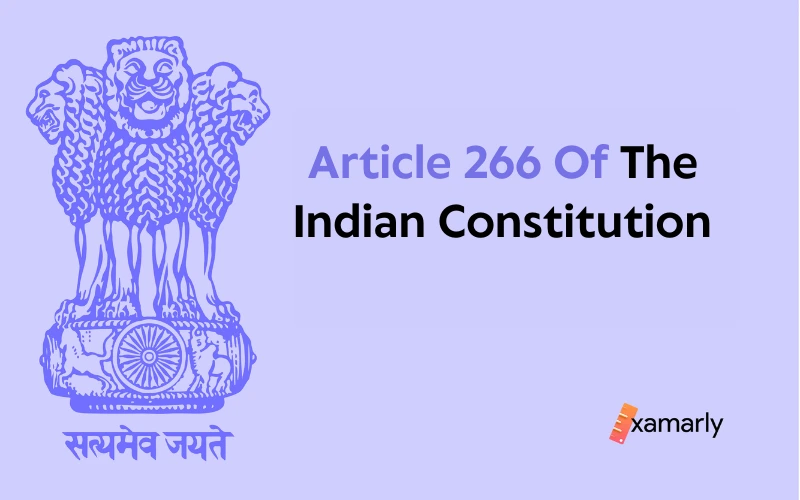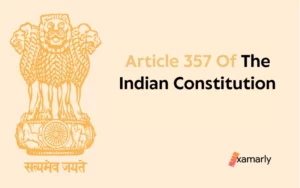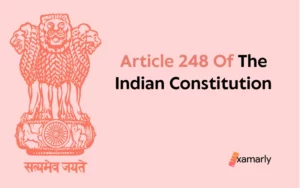Do you know how your tax money is spent by the government? Have you ever wondered what Article 266 of the Indian Constitution says regarding public funds?
The Indian Constitution is one of the longest constitutions in the world and it covers a broad range of issues. Article 266 deals with Consolidated Funds and public accounts of India and the States.
Article 266 of the Indian Constitution requires governments to maintain their fund balance in special accounts known as ‘Consolidated Funds.’ In this article, we will look at exactly what Article 266 states and examine other related constitutional provisions.
- What Is Article 266 Of The Indian Constitution?
- When Article 266 Was Approved?
- Funds Of Governments Of India
- Conclusion
- UPSC PYQs On Article 266
- FAQs On Article 266
- What Is The Consolidated Fund Of India?
- What Is The Public Accounts Of India?
- How Many Types Of Funds Of Government Of India Have?
- What Is Article 266 Of The Indian Constitution?
- What Is Article 267 Of The Indian Constitution?
- Which Article Of The Constitution Of India Formed The Consolidated Fund Of States?
What Is Article 266 Of The Indian Constitution?
Article 266 of the Indian Constitution covers both the Consolidated Funds and the public accounts of India and the States. The provisions of the said Article are covered in the following 3 clauses:
- Subject to the provisions of Article 267 and provisions of Chapter 1 (Part XII) regarding the assignment of all or part of the net proceeds of certain taxes and duties to States, all revenues received by the Government of India, all loans raised by that Government by issuing treasury bills, loans, or ways and means advances, and all money received by that Government in repayment of loans shall be put into one fund called “the Consolidated Fund of India” and all revenues received by the government of a state, as well as all loans raised by that government by the issuance of treasury bills, loans, or ways and means advances, as well as all money received by that government in loan repayment, must form one consolidated fund that shall be termed “the Consolidated Fund of the State.”
- The public account of India or the public account of the State, as applicable, should be credited with all additional public money acquired by or on behalf of the Government of India or the Government of a State.
- Except as authorized by law and only for the purposes and in the ways specified in this Constitution, no funds from the Consolidated Fund of India or the Consolidated Fund of a State may be appropriated.
When Article 266 Was Approved?
On August 4, 1949, a discussion centered on Draft Article 248A (also known as Article 266). It was initially left out of the 1948 Draft Constitution of India. The Chairman of the Drafting Committee in the Constituent Assembly was the one who initially presented it to the assembly.
In accordance with this draught article, the Consolidated Fund of India and the Consolidated Funds of the States were established. These Funds would hold all of the funds that the Union and State governments raised or received. The said Article was not the subject of any meaningful discussion.
On August 4, 1949, the proposed Draft Article 248A of the Constitution was approved.
Funds Of Governments Of India
Following are the three divisions into which the Indian government’s funds are divided:
- Consolidated Fund of India (mentioned in Article 266)
- Contingency Fund of India (mentioned in Article 267)
- Public Accounts of India (mentioned in Article 266)
Conclusion
Article 266 of the Constitution of India deals with the Consolidated Funds and public accounts of the Union and the states. The fund to which all receipts and expenditures are credited and debited is known as the Consolidated Fund of India. In accordance with Article 266(1) of the Indian Constitution, the Consolidated Fund of India was created.
In the interest of further readings:
UPSC PYQs On Article 266
All revenues received by the Union Government by way of taxes and other receipts for the conduct of Government business are credited to the: (UPSC 2011)
(a) Contingency Fund of India
(b) Public Account
(c) Consolidated Fund of India
(d) Deposits and Advances Fund
Ans. (c)
Explanation: The Consolidated Fund is used to hold all of the government’s receipts for taxes such as Income Tax, Central Excise, Customs, and other receipts streaming to the government in conjunction with the conduct of government activity, or Non-Tax Revenues. The Consolidated Fund of India is formed under Article 266.
As a result, choice (c) is the right response.
FAQs On Article 266
What Is The Consolidated Fund Of India?
Under this article, the Consolidated Fund of India is the fund to which all revenues received by the government, all loans raised by the government, and all money received by the government in repayment of loans must be credited. No money can be withdrawn from the Consolidated Fund except under the authority of law and for the purposes and in the manner provided in the Constitution. The Consolidated fund covers the majority of government expenditures.
What Is The Public Accounts Of India?
This account/fund is used to hold all additional public money that the Indian Government receives (other than those that fall within the Consolidated Fund of India).
How Many Types Of Funds Of Government Of India Have?
Three different forms of central government funds are mentioned in the Indian Constitution: the Public Accounts of India (Article 266), the Contingency Fund of India, and the Consolidated Fund of India (Articles 266 and 267).
What Is Article 266 Of The Indian Constitution?
Both the Consolidated Funds and the public accounts of India and the States are covered by Article 266 of the Indian Constitution.
What Is Article 267 Of The Indian Constitution?
Article 267 of the Indian Constitution deals with the Contingency funds of India in Part XII of the Indian Constitution.
Which Article Of The Constitution Of India Formed The Consolidated Fund Of States?
Article 266 of the Indian Constitution established the Consolidated fund of the States.






